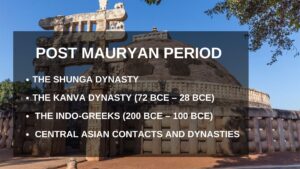The period following the decline of the Mauryan Empire, from around 200 BCE onwards, is termed the Post-Mauryan Period. While this era did not witness the rise of a singular, vast empire like the Mauryas, it was marked by significant political, cultural, and economic developments. The intimate interactions between Central Asia and India during this time left a lasting impact on the subcontinent’s history.
Post Mauryan period
Following Ashoka’s death, various small kingdoms declared independence, leading to political fragmentation. The last Mauryan king, Brihadratha, was assassinated by Pushyamitra Shunga, the Mauryan army chief, marking the end of the Mauryan dynasty.
This period saw the rise of multiple ruling dynasties, including the Shungas, Kanvas, and Satvahanas in central and southern India. Meanwhile, northwestern India experienced several invasions from Central Asian groups like the Indo-Greeks, Sakas, Parthians, and Kushanas.
Read about Mauryan Empire
1. The Shunga Dynasty (185 BCE – 73 BCE)
Pushyamitra Shunga (185 BCE – 149 BCE)
Pushyamitra Shunga, originally a Mauryan army chief, established the Shunga dynasty after assassinating Brihadratha in 180 BCE. This coup is often viewed as a Brahminical reaction to the significant patronage that Buddhism received under the Mauryas. The Ashokavadana records that Pushyamitra carried out destruction at Buddhist sites, including the Sanchi Stupa.
The Shunga kingdom extended over the Ganges Valley and northern India, reaching down to the Narmada River. During his reign, Pushyamitra had to defend his territory from Bactrian Greek invasions, particularly in Punjab.
Cultural and Political Contributions
Pushyamitra’s son, Agnimitra, succeeded him and was known for being a patron of Buddhism. His reign is depicted in Kalidasa’s Malvikagnimitram. The Shunga rule witnessed a revival of Hinduism, an emphasis on Sanskrit, and the resurgence of varna-based social hierarchy.
The Shunga dynasty eventually declined, and the last ruler, Devabhuti, was assassinated by his minister Vasudeva, who established the Kanva dynasty.

2. The Kanva Dynasty (72 BCE – 28 BCE)
The Kanvas ruled over Magadha and continued the administrative system introduced by the Mauryas. They were eventually overthrown by the Andhras in the Deccan, leading to the rise of the Satavahana dynasty. Meanwhile, in North India, smaller kingdoms like the Mitras of Kaushambi emerged.
Impact of Shunga and Kanva Rule
- Revival of Hindu traditions and Sanskrit language.
- Resurgence of gana-sangha polities in Punjab.
- Continued influence of Mauryan administrative systems.
3. The Indo-Greeks (200 BCE – 100 BCE)
The Indo-Greeks were the first Central Asian invaders to cross the Hindukush mountains into India. They were originally Bactrian Greeks who were pushed southward due to pressure from the Scythians. The Indo-Greeks, known as Yavanas in Indian texts, introduced significant cultural and economic changes.
Notable Indo-Greek Rulers
Two prominent Indo-Greek dynasties were founded by Demetrius and Eucratides. Menander (165–145 BCE), also known as Milinda, was the most renowned Indo-Greek ruler. He ruled from Sakala (modern Sialkot) and expanded his influence into the Ganga-Yamuna Doab. He later converted to Buddhism under the guidance of the monk Nagasena, as recorded in Milinda Panha.
Influence of Indo-Greeks
- Coinage: They introduced gold coins, which influenced later Indian rulers.
- Military Innovations: They introduced the satrapy system, a form of military governorship.
- Trade Expansion: The spice trade with Central Asia flourished.
- Hellenistic Art: Indo-Greeks blended Greek, Roman, and Indian artistic traditions, seen in Gandhara art.
4. Central Asian Contacts and Dynasties
Following the Indo-Greeks, various Central Asian groups such as the Sakas, Parthians, and Kushanas migrated into India.
1. Saka Dynasty (1st Century BCE – 4th Century CE)
The Sakas, originally a steppe tribe, entered India through the Bolan Pass. They established rule in western India, contesting territories in Mathura and Ujjain. In 57 BCE, a king of Ujjain, Vikramaditya, defeated the Sakas and established the Vikrama Era calendar.
Read about Decline of Harappan Civilization
Key Rulers
- Maues (Moga): The first Saka king in India.
- Rudradaman I (130–150 CE): Known for his Junagarh Inscription, which recorded his repair of Sudarshan Lake in Gujarat. He also made peace with the Satavahanas through a matrimonial alliance.
2. The Indo-Parthians
The Parthians, known as Pahalavas, controlled regions west of the Indus River before moving into India. Their most famous ruler, Gondophernes (19–46 CE), is associated with the arrival of St. Thomas, who introduced Christianity to India.
3. The Kushana Dynasty (30 CE – 250 CE)
The Kushanas were one of five clans of the Yuezhis from Central Asia. Their rise marked a golden age in trade, religion, and art.
Key Rulers
- Kujula Kadphises (30–80 CE): Established Kushana rule in India.
- Kanishka (127–147 CE): The most famous Kushana ruler, known from the Rabatak Inscription. His empire stretched from Afghanistan to Pataliputra.
Impact of the Kushanas
- Trade: The Kushanas controlled the Silk Route, benefiting from tolls on traders.
- Feudalism: They introduced a system of feudal governance.
- Religious Patronage: Kanishka hosted the fourth Buddhist council and supported Mahayana Buddhism.
- Art and Culture: Kushanas contributed to the Gandhara and Mathura schools of art.
- Scientific Advancements: Scholars like Charaka (medicine) and Ashvaghosha (Buddhist philosophy) flourished under their patronage.
Legacy of the Post-Mauryan Period
Despite political fragmentation, the Post-Mauryan period played a crucial role in shaping Indian civilization. It facilitated cross-cultural exchanges, trade expansions, and advancements in governance, art, and literature. The period laid the foundation for the classical age of Indian history, proving that even in times of political upheaval, cultural and economic resilience could thrive.


